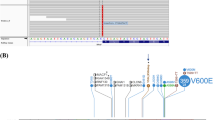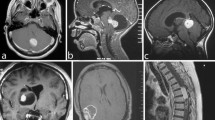Abstract
Recent advances in the genomic study have revolutionized the discovery of molecular biomarkers in glioma not only to aid in targeted therapy but also to prognosticate character of tumor and outcome of a patient.
The usually benign nature of pilocytic astrocytoma (PA) can now be challenged with the discovery of genomic alterations that could promote more aggressive clinical behavior. CDKN2A deletion and ATRX gene inactivation or mutation have been the most common molecular alterations in worse prognosis.
We will discuss a case of pilocytic astrocytoma showing the progressive recurrence with pilomyxoid features and the presence of TERT promoter mutation.




Similar content being viewed by others
References
Akincilar SC, Unal B, Tergaonkar V (2016) Reactivation of telomerase in cancer. Cell Mol Life Sci 73(8):1659–1670
Akyerli CB, Yüksel Ş, Can Ö, Erson-Omay EZ, Oktay Y, Coşgun E, Özduman K (2018) Use of telomerase promoter mutations to mark specific molecular subsets with reciprocal clinical behavior in IDH mutant and IDH wild-type diffuse gliomas. J Neurosurg 128(4):1102–1114
Belirgen M, Berrak SG, Ozdag H, Bozkurt SU, Eksioglu-Demiralp E, Ozek MM (2012) Biologic tumor behavior in pilocytic astrocytomas. Childs Nerv Syst 28(3):375–389
Bernell WR, Kepes JJ, Seitz EP (1972) Late malignant recurrence of childhood cerebellar astrocytoma. Report of two cases. J Neurosurg 37:470474
Brat DJ, Aldape K, Colman H, Holland EC, Louis DN, Jenkins RB, Weller M (2018) cIMPACT-NOW update 3: recommended diagnostic criteria for “Diffuse astrocytic glioma, IDH-wildtype, with molecular features of glioblastoma, WHO grade IV”. Acta Neuropathol
Brito C, Azeved A, Esteves S (2019) Clinical insights gained by refining the 2016 WHO classification of diffuse glioma with ECFR amplification, TERT mutations, PTEN deletions and MGMT methylation. BMC Cancer 19:968
Burkhard C, Di Patre P-L, Schumer D, Schumer G, Ohgaki H (2003) A population-based study of the incidence and survival rates in patients with pilocytic astrocytoma. J Neurosurg 98(6):1170–1174
Ceppa EP, Bouffet E, Griebel R, Robinson C, Tihan T (2007) The pilomyxoid astrocytoma and its relationship to pilocytic astrocytoma: report of a case and a critical review of the entity. J Neuro-Oncol 81:191–196
Chiba K, Johnson JZ, Vogan JM, Wagner T, Boyle JM, Hockemeyer D (2015) Cancer-associated TERT promoter mutations abrogate telomerase silencing. Elife 4
Eckel-Passow JE, Lachance DH, Molinaro AM, Walsh KM, Decker PA, Sicotte H, Jenkins RB (2015) Glioma groups based on 1p/19q, IDH, and TERT promoter mutations in tumors. N Engl J Med 372(26):2499–2508
Ichimura K (2019) TERT promoter mutation as a diagnostic marker for diffuse gliomas. Neuro-Oncology xx(xx):1–2
Karsy M, Guan J, Cohen AL, Jensen RL, Colman H (2017) New molecular considerations for glioma. Curr Neurol Neurosci Rep 17(19)
Killela PJ, Reitman ZJ, Jiao Y (2013) TERT promoter mutations occur frequently in gliomas and a subset of tumors derived from cells with low rates of self renewals. PNAS 110(15):6021–6026
Labussiere M, Di Stefano AL, Gleize V, Boisselier B, Giry M, Magesius S et al (2014) TERT promoter mutation in gliomas, genetic associations & clinicopathological correlation. Br J Cancer 111(10):2024–2032
Li KKW, Yang R, Chan AKY et al (2017) PATH-34. H3F3A and TERT promoter mutations are poor prognosticators in pediatric low grade gliomas. Neuro-Oncology 19(Suppl 6):vi178
Mcneil KA (2016) Epidemiology of brain tumors. Neurol Clin 34(4):981–998
Ostrom QT, Cioffi G, Gittleman H, Patil N, Waite K, Kruchko C, Barnholtz-Sloan JS (2019) CBTRUS statistical report: primary brain and other central nervous system tumors diagnosed in the United States in 2012–2016. Neuro-Oncology 21:v1–v100
Peter Collins V, James DTW, Giannini C (2015) Pilocytic astrocytoma: pathology, molecular mechanisms and markers. Acta Neuropathol
Phillips JJ, Gong H, Chen K, Joseph NM, van Ziffle J, Bastian BC, Solomon DA (2018) The genetic landscape of anaplastic pleomorphic xanthoastrocytoma. Brain Pathol
Reinhardt A, Stichel D, Schrimpf D, Sahm F, Korshunov A, Reuss DE, Hovestadt V (2018) Anaplastic astrocytoma with piloid features, a novel molecular class of IDH wildtype glioma with recurrent MAPK pathway, CDKN2A/B and ATRX alterations. Acta Neuropathol 136(2):273–291
Rodriguez FJ, Brosnan-Cashman JA, Allen SJ et al (2019) Alternative lengthening of telomeres, ATRX loss and H3-K27M mutations in histologically defined pilocytic astrocytoma with anaplasia. Brain Pathol 29(1):126–140
Schiffman JD, Hodgson JG, VandenBerg SR et al (2010) Oncogenic BRSF mutation with CDKN2A inactivation is characteristic of a subset of pediatric malignant astrocytoma. Cancer Res 70:512–519
Sharma MK, Mansur DB, Reifenberger G, Perry A, Leonard JR, Aldape KD, Albin MG, Emnett RJ, Loeser S, Watson MA, Nagarajan R, Gutmann DH (2007) Distinct genetic signatures among pilocytic astrocytomas relate to their brain region origin. Cancer Res 67:890–900
Trisha K et al (2019) PATH-52. Anaplastic pilomyxoid astrocytoma harboring BRAF FUSION, PTEN and TERT mutations. Neuro-Oncology 21. Supplement_6
Author information
Authors and Affiliations
Corresponding author
Ethics declarations
Conflict of interest
The authors declare that they have no conflict of interest. Dr. Jacintha Vikeneswary Francis, MBBS, attends a pediatric neurosurgery fellowship program in our department which is sponsored by KARL STORZ Company.
Additional information
Publisher’s note
Springer Nature remains neutral with regard to jurisdictional claims in published maps and institutional affiliations.
Rights and permissions
About this article
Cite this article
Francis, J.V., Tanrıkulu, B., Danyeli, A.E. et al. Is it a new culprit? “TERT promoter mutation” in an aggressive pediatric pilocytic astrocytoma. Childs Nerv Syst 37, 1003–1008 (2021). https://doi.org/10.1007/s00381-020-04803-3
Received:
Accepted:
Published:
Issue Date:
DOI: https://doi.org/10.1007/s00381-020-04803-3




